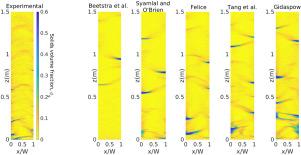带液体注入的隔水管系统的三相 CFD-DEM 流体动力学研究
IF 13.3
1区 工程技术
Q1 ENGINEERING, CHEMICAL
引用次数: 0
摘要
立管反应器经常被应用于加工工业中非常重要的催化过程。在这项工作中,针对带有液体注入的立管开发了一种计算流体动力学-离散元素法(CFD-DEM)。该模型将气体视为连续相,而液滴和催化剂颗粒则被视为离散元素。液滴的存在会导致颗粒潮湿,这一点可通过颗粒的覆盖模型加以考虑。此外,颗粒上的液体会改变碰撞行为,这将通过能量平衡方法加以考虑。这项 CFD-DEM 研究模拟的是实验室规模的伪 2D 立管。根据比较结果,假设颗粒完全覆盖会导致立管的固体滞留和聚类行为显著增加,尤其是在低液体流速时,会导致预测过高。部分覆盖模拟显示,只有一半的颗粒被覆盖,这对碰撞有很大影响。本文章由计算机程序翻译,如有差异,请以英文原文为准。

Three-phase CFD-DEM study on the hydrodynamics of a riser system with liquid injection
Riser reactors are frequently applied in the process industry for highly important catalytic processes. In this work, a computational fluid dynamics- discrete element method (CFD-DEM) for a riser with liquid injection was developed. This model treats the gas as a continuous phase whereas the liquid droplets and catalyst particles are treated as discrete elements. The presence of droplets causes particles to be wet, which is taken into account via coverage models of the particles. In addition, the liquid on the particles will change the collision behavior, which is included using an energy balance approach. This CFD-DEM study is conducted simulating a lab-scale pseudo-2D riser. Based on the comparison, the assumption of fully covered particles results in a significant increase in the solids holdup and clustering behavior of the riser which, especially at the low liquid flow rate, results in an over-prediction. The partial coverage simulations show that only half of the particles are covered, which has a major effect on the collisions.
求助全文
通过发布文献求助,成功后即可免费获取论文全文。
去求助
来源期刊

Chemical Engineering Journal
工程技术-工程:化工
CiteScore
21.70
自引率
9.30%
发文量
6781
审稿时长
2.4 months
期刊介绍:
The Chemical Engineering Journal is an international research journal that invites contributions of original and novel fundamental research. It aims to provide an international platform for presenting original fundamental research, interpretative reviews, and discussions on new developments in chemical engineering. The journal welcomes papers that describe novel theory and its practical application, as well as those that demonstrate the transfer of techniques from other disciplines. It also welcomes reports on carefully conducted experimental work that is soundly interpreted. The main focus of the journal is on original and rigorous research results that have broad significance. The Catalysis section within the Chemical Engineering Journal focuses specifically on Experimental and Theoretical studies in the fields of heterogeneous catalysis, molecular catalysis, and biocatalysis. These studies have industrial impact on various sectors such as chemicals, energy, materials, foods, healthcare, and environmental protection.
 求助内容:
求助内容: 应助结果提醒方式:
应助结果提醒方式:


